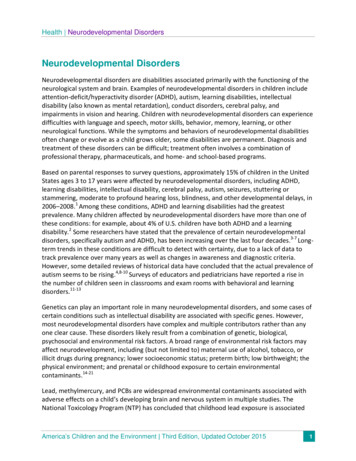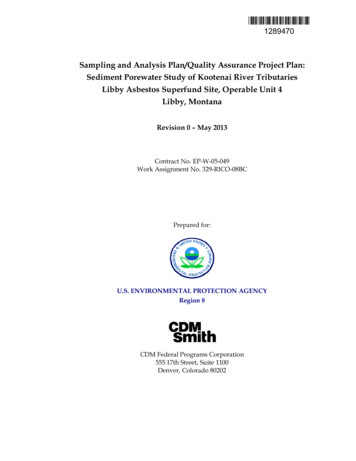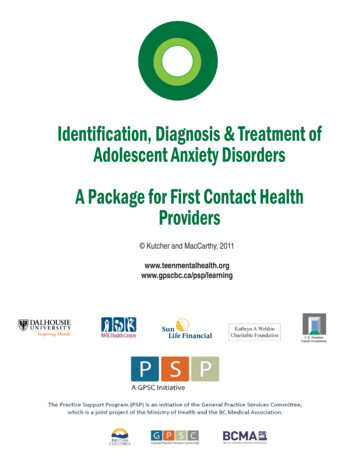
Transcription
Health Neurodevelopmental DisordersNeurodevelopmental DisordersNeurodevelopmental disorders are disabilities associated primarily with the functioning of theneurological system and brain. Examples of neurodevelopmental disorders in children includeattention-deficit/hyperactivity disorder (ADHD), autism, learning disabilities, intellectualdisability (also known as mental retardation), conduct disorders, cerebral palsy, andimpairments in vision and hearing. Children with neurodevelopmental disorders can experiencedifficulties with language and speech, motor skills, behavior, memory, learning, or otherneurological functions. While the symptoms and behaviors of neurodevelopmental disabilitiesoften change or evolve as a child grows older, some disabilities are permanent. Diagnosis andtreatment of these disorders can be difficult; treatment often involves a combination ofprofessional therapy, pharmaceuticals, and home- and school-based programs.Based on parental responses to survey questions, approximately 15% of children in the UnitedStates ages 3 to 17 years were affected by neurodevelopmental disorders, including ADHD,learning disabilities, intellectual disability, cerebral palsy, autism, seizures, stuttering orstammering, moderate to profound hearing loss, blindness, and other developmental delays, in2006–2008.1 Among these conditions, ADHD and learning disabilities had the greatestprevalence. Many children affected by neurodevelopmental disorders have more than one ofthese conditions: for example, about 4% of U.S. children have both ADHD and a learningdisability.2 Some researchers have stated that the prevalence of certain neurodevelopmentaldisorders, specifically autism and ADHD, has been increasing over the last four decades.3-7 Longterm trends in these conditions are difficult to detect with certainty, due to a lack of data totrack prevalence over many years as well as changes in awareness and diagnostic criteria.However, some detailed reviews of historical data have concluded that the actual prevalence ofautism seems to be rising.4,8-10 Surveys of educators and pediatricians have reported a rise inthe number of children seen in classrooms and exam rooms with behavioral and learningdisorders.11-13Genetics can play an important role in many neurodevelopmental disorders, and some cases ofcertain conditions such as intellectual disability are associated with specific genes. However,most neurodevelopmental disorders have complex and multiple contributors rather than anyone clear cause. These disorders likely result from a combination of genetic, biological,psychosocial and environmental risk factors. A broad range of environmental risk factors mayaffect neurodevelopment, including (but not limited to) maternal use of alcohol, tobacco, orillicit drugs during pregnancy; lower socioeconomic status; preterm birth; low birthweight; thephysical environment; and prenatal or childhood exposure to certain environmentalcontaminants.14-21Lead, methylmercury, and PCBs are widespread environmental contaminants associated withadverse effects on a child’s developing brain and nervous system in multiple studies. TheNational Toxicology Program (NTP) has concluded that childhood lead exposure is associatedAmerica’s Children and the Environment Third Edition, Updated October 20151
Neurodevelopmental Disorders Healthwith reduced cognitive function, including lower intelligence quotient (IQ) and reducedacademic achievement.22 The NTP has also concluded that childhood lead exposure isassociated with attention-related behavioral problems (including inattention, hyperactivity, anddiagnosed attention-deficit/hyperactivity disorder) and increased incidence of problembehaviors (including delinquent, criminal, or antisocial behavior).22EPA has determined that methylmercury is known to have neurotoxic and developmentaleffects in humans.23 Extreme cases of such effects were seen in people prenatally exposedduring two high-dose mercury poisoning events in Japan and Iraq, who experienced severeadverse health effects such as cerebral palsy, mental retardation, deafness, and blindness.24-26Prospective cohort studies have been conducted in island populations where frequent fishconsumption leads to methylmercury exposure in pregnant women at levels much lower thanin the poisoning incidents but much greater than those typically observed in the United States.Results from such studies in New Zealand and the Faroe Islands suggest that increased prenatalmercury exposure due to maternal fish consumption was associated with adverse effects onintelligence and decreased functioning in the areas of language, attention, and memory.26-32These associations were not seen in initial results reported from a similar study in theSeychelles Islands.33 However, further studies in the Seychelles found associations betweenprenatal mercury exposure and some neurodevelopmental deficits after researchers hadaccounted for the developmental benefits of fish consumption.34-36 More recent studiesconducted in the United States have found associations between neurodevelopmental effectsand blood mercury levels within the range typical for U.S. women, after accounting for thebeneficial effects of fish consumption during pregnancy.32,37,38Several studies of children who were prenatally exposed to elevated levels of polychlorinatedbiphenyls (PCBs) have suggested linkages between these contaminants andneurodevelopmental effects, including lowered intelligence and behavioral deficits such asinattention and impulsive behavior.39-44 Studies have also reported associations between PCBexposure and deficits in learning and memory.39,45 Most of these studies found that the effectsare associated with exposure in the womb resulting from the mother having eaten foodcontaminated with PCBs,46-51 although some studies have reported relationships betweenadverse effects and PCB exposure during infancy and childhood.45,51-53 Although there is someinconsistency in the epidemiological literature, several reviews of the literature have found thatthe overall evidence supports a concern for effects of PCBs on children’s neurologicaldevelopment.52,54-58 The Agency for Toxic Substances and Disease Registry has determined that“Substantial data suggest that PCBs play a role in neurobehavioral alterations observed innewborns and young children of women with PCB burdens near background levels.”59 Inaddition, adverse effects on intelligence and behavior have been found in children of womenwho were highly exposed to mixtures of PCBs, chlorinated dibenzofurans, and other pollutantsprior to conception.60-63A wide variety of other environmental chemicals have been identified as potential concerns forchildhood neurological development, but have not been as well studied for these effects aslead, mercury, and PCBs. Concerns for these additional chemicals are based on both laboratory2America’s Children and the Environment Third Edition, Updated October 2015
Health Neurodevelopmental Disordersanimal studies and human epidemiological research; in most cases, the epidemiological studiesare relatively new and the literature is just beginning to develop. Among the chemicals beingstudied for potential effects on childhood neurological development are organophosphatepesticides, polybrominated diphenyl ether flame retardants (PBDEs), phthalates, bisphenol A(BPA), polycyclic aromatic hydrocarbons (PAHs), arsenic, and perchlorate. Exposure to all ofthese chemicals is widespread in the United States for both children and adults.64Organophosphate pesticides can interfere with the proper function of the nervous system whenexposure is sufficiently high.65 Many children may have low capacity to detoxify organophosphatepesticides through age 7 years.66 In addition, recent studies have reported an associationbetween prenatal organophosphate exposure and childhood ADHD in a U.S. community withrelatively high exposures to organophosphate pesticides,67 as well as with exposures found withinthe general U.S. population.68 Other recent studies have described associations between prenatalorganophosphate pesticide exposures and a variety of neurodevelopmental deficits in childhood,including reduced IQ, perceptual reasoning, and memory.69-71Studies of certain PBDEs have found adverse effects on behavior, learning, and memory inlaboratory animals.72-74 A recent epidemiological study in New York City reported significantassociations between children’s prenatal exposure to PBDEs and reduced performance on IQtests and other tests of neurological development in 6-year-old children.75 Another study in theNetherlands reported significant associations between children’s prenatal exposure to PBDEsand reduced performance on some neurodevelopmental tests in 5- and 6-year-old children,while associations with improved performance were observed for other tests.76Two studies of a group of New York City children ages 4 to 9 years reported associationsbetween prenatal exposure to certain phthalates and behavioral deficits, including effects onattention, conduct, and social behaviors.77,78 Some of the behavioral deficits observed in thesestudies are similar to those commonly displayed in children with ADHD and conduct disorder.Studies conducted in South Korea of children ages 8 to 11 years reported that children withhigher levels of certain phthalate metabolites in their urine were more inattentive andhyperactive, displayed more symptoms of ADHD, and had lower IQ compared with those whohad lower levels.79,80 The exposure levels in these studies are comparable to typical exposuresin the U.S. population.In 2008, the NTP concluded that there is “some concern” for effects of early-life (includingprenatal) BPA exposure on brain development and behavior, based on findings of animalstudies conducted at relatively low doses.81 An epidemiological study conducted in Ohioreported an association between prenatal exposure to BPA and effects on children’s behavior(increased hyperactivity and aggression) at age 2 years.82 Another study of prenatal BPAexposure in New York City reported no association between prenatal BPA exposure and socialbehavior deficits in testing conducted at ages 7 to 9 years.78A series of recent studies conducted in New York City has reported that children of women whowere exposed to increased levels of polycyclic aromatic hydrocarbons (PAHs, produced whenAmerica’s Children and the Environment Third Edition, Updated October 20153
Neurodevelopmental Disorders Healthgasoline and other materials are burned) during pregnancy are more likely to have experiencedadverse effects on neurological development (for example, reduced IQ and behavioralproblems).83,84Early-life exposure to arsenic has been associated with measures of reduced cognitive function,including lower scores on tests that measure neurobehavioral and intellectual development, infour studies conducted in Asia; however there are some inconsistencies in the findings of thesestudies.85 These findings are from countries where arsenic levels in drinking water are generallymuch higher than in the United States due to high levels of naturally occurring arsenic ingroundwater.86Perchlorate is a naturally occurring and man-made chemical that has been found in drinkingwater87 and foods88,89 in the United States. Exposure to elevated levels of perchlorate inhibitsiodide uptake into the thyroid gland, thus possibly disrupting the function of the thyroid andpotentially leading to a reduction in the production of thyroid hormone.90,91 Moderate deficitsin maternal thyroid hormone levels during early pregnancy have been linked to reducedchildhood IQ scores and other neurodevelopmental effects.92-94Interactions of environmental contaminants and other environmental factors may combine toincrease the risk of neurodevelopmental disorders. For example, exposure to lead may havestronger effects on neurodevelopment among children with lower socioeconomic status.21,95A child’s brain and nervous system are vulnerable to adverse impacts from pollutants becausethey go through a long developmental process beginning shortly after conception andcontinuing through adolescence.96,97 This complex developmental process requires the precisecoordination of cell growth and movement, and may be disrupted by even short-termexposures to environmental contaminants if they occur at critical stages of development. Thisdisruption can lead to neurodevelopmental deficits that may have an effect on the child’sachievements and behavior even when they do not result in a diagnosable disorder.Attention-Deficit/Hyperactivity Disorder (ADHD)Attention-deficit/hyperactivity disorder (ADHD) is a disruptive behavior disorder characterizedby symptoms of inattention and/or hyperactivity-impulsivity, occurring in several settings andmore frequently and severely than is typical for other individuals in the same stage ofdevelopment.98 ADHD can make family and peer relationships difficult, diminish academicperformance, and reduce vocational achievement.As the medical profession has developed a greater understanding of ADHD through the years,the name of this condition has changed. The American Psychiatric Association adopted thename “attention deficit disorder” in the early 1980s and revised it to “attentiondeficit/hyperactivity disorder” in 1987.99 Many children with ADHD have a mix of inattentionand hyperactivity/impulsivity behaviors, while some may display primarily hyperactive behaviortraits, and others display primarily inattentive traits. It is possible for an individual’s primary4America’s Children and the Environment Third Edition, Updated October 2015
Health Neurodevelopmental Disorderssymptoms of ADHD to change over time.20 Children with ADHD frequently have other disorders,with parents reporting that about half of children with ADHD have a learning disability andabout one in four have a conduct disorder.2,100Other disorders, including anxiety disorders, depression, and learning disabilities, can beexpressed with signs and symptoms that resemble those of ADHD. A diagnosis of ADHDrequires a certain amount of judgment on the part of a doctor, similar to diagnosis of othermental disorders. Despite the variability among children diagnosed with the disorder and thechallenges involved in diagnosis, ADHD has good clinical validity, meaning that impairedchildren share similarities, exhibit symptoms, respond to treatment, and are recognized withgeneral consistency across clinicians.20A great deal of research on ADHD has focused on aspects of brain functioning that are relatedto the behaviors associated with ADHD. Although this research is not definitive, it has foundthat children with ADHD generally have trouble with certain skills involved in problem-solving(referred to collectively as executive function). These skills include working memory (keepinginformation in mind while briefly doing something else), planning (organizing a sequence ofactivities to complete a task), response inhibition (suppressing immediate responses when theyare inappropriate), and cognitive flexibility (changing an approach when a situation changes).Children with ADHD also generally have problems in maintaining sustained attention to a task(referred to as vigilance), and/or maintaining readiness to respond to new information(referred to as alertness).20,101,102While uncertainties remain, findings to date indicate that ADHD is caused by combinations ofgenetic and environmental factors. 20,103-106 Much of the research on environmental factors hasfocused on the fetal environment. Maternal smoking during pregnancy has been associatedwith increased risk of ADHD in the child in numerous studies, however, this continues to be anactive area of research as scientists consider whether other factors related to smoking (e.g.,genetic factors, maternal mental health, stress, alcohol use, and low birth weight) may beresponsible for associations attributed to smoking.17,19,107 Findings regarding ADHD andmaternal consumption of alcohol during pregnancy are considered more limited andinconsistent.19,20 Preterm birth and low birth weight have also been found to increase thelikelihood that a child will have ADHD.16,18,20 Psychosocial adversity (representing factors suchas low socioeconomic status and in-home conflict) in childhood may also play a role in ADHD.108The potential role of environmental contaminants in contributing to ADHD, either alone or inconjunction with certain genetic susceptibilities or other environmental factors, is becomingbetter understood as a growing number of studies look explicitly at the relationship betweenADHD and exposures to environmental contaminants.Among environmental contaminants known or suspected to be developmental neurotoxicants,lead has the most extensive evidence of a potential contribution to ADHD. A number of recentepidemiological studies (all published since 2006, with data gathered beginning in 1999 or morerecently) conducted in the United States and Asia have reported relationships betweenAmerica’s Children and the Environment Third Edition, Updated October 20155
Neurodevelopmental Disorders Healthincreased levels of lead in a child’s blood and increased likelihood of ADHD.55,109-115 In most ofthese studies, blood lead levels were comparable to levels observed currently in the UnitedStates. The potential contribution of childhood lead exposure to the risk of ADHD may beamplified in children of women who smoked cigarettes during pregnancy.110 In addition, severalstudies have reported relationships between blood lead levels and the aspects of brainfunctioning that are most affected in children with ADHD, including sustained attention,alertness, and problem-solving skills (executive functions, specifically cognitive flexibility,working memory, planning, and response inhibition).22,44,55,116-119 Similar results have beenobserved in laboratory animal studies.55,96,120-122 The NTP has concluded that childhood leadexposure is “associated with increased diagnosis of attention-related behavioral problems.”22Although no studies evaluating a potential association between PCBs and ADHD itself have beenpublished, a study in Massachusetts reported a relationship between levels of PCBs measured incord blood and increased ADHD-like behaviors observed by teachers in children at ages 7 to 11years. PCB levels in this study were generally lower than those measured in other epidemiologicalstudies of PCBs and childhood neurological development.40 Other research findings also suggestthat PCBs may play a role in contributing to ADHD. Several studies in U.S. and Europeanpopulations, most having elevated exposure to PCBs through the diet, have found generallyconsistent associations with aspects of brain function that are most affected in children withADHD, including alertness and problem-solving skills (executive functions, specifically responseinhibition, working memory, cognitive flexibility, and planning).54,55 Studies in laboratory animalshave similar findings regarding the mental functions affected by PCB exposure.55,96Studies of other environmental chemicals reporting associations with ADHD or relatedoutcomes have been published in recent years, but findings tend to be much more limited thanfor lead and PCBs. Findings for phthalates and organophosphate pesticides were noted above.In addition, three studies have reported associations between ADHD or impulsivity andconcentrations of certain perfluorinated chemicals measured in the blood of children.123-125Studies of mercury have produced generally mixed findings of associations with ADHD orrelated symptoms and mental functions.29,111,118,126-128Learning DisabilityLearning disability (or learning disorder) is a general term for a neurological disorder thataffects the way in which a child’s brain can receive, process, retain, and respond to information.A child with a learning disability may have trouble learning and using certain skills, includingreading, writing, listening, speaking, reasoning, and doing math, although learning disabilitiesvary from child to child. Children with learning disabilities usually have average or aboveaverage intelligence, but there are differences in the way their brains process information.129As with many other neurodevelopmental disorders, the causes of learning disabilities are notwell understood. Often learning disabilities run in the family, suggesting that heredity may playa role in their development. Problems during pregnancy and birth, such as drug or alcohol use6America’s Children and the Environment Third Edition, Updated October 2015
Health Neurodevelopmental Disordersduring pregnancy, low birth weight, lack of oxygen, or premature or prolonged labor, may alsolead to learning disabilities.130As is the case with other neurodevelopmental outcomes, there are generally many morestudies of lead exposure that are relevant to learning disabilities than for other environmentalcontaminants. Several studies have found associations between lead exposure and learningdisabilities or reduced classroom performance that are independent of IQ.119,120,131-133Exposures to lead have been associated with impaired memory and difficulties or impairmentsin rule learning, following directions, planning, verbal abilities, speech processing, andclassroom performance in children.22,119,131,134-137 Other findings that may indicate contributionsfrom environmental contaminants to learning disabilities include a study that foundassociations of both maternal smoking during pregnancy and childhood exposure toenvironmental tobacco smoke with parent report of a child with a learning disabilitydiagnosis;138 associations of prenatal mercury exposure with dysfunctions in children’s languageabilities and memory,29,30 and associations of prenatal PCB exposure with poorer concentrationand memory deficits compared with unexposed children.39,45Autism Spectrum DisordersAutism spectrum disorders (ASDs) are a group of developmental disabilities defined bysignificant social, communication, and behavioral impairments. The term “spectrum disorders”refers to the fact that although people with ASDs share some common symptoms, ASDs affectdifferent people in different ways, with some experiencing very mild symptoms and othersexperiencing severe symptoms. ASDs encompass autistic disorder and the generally less severeforms, Asperger’s syndrome and pervasive developmental disorder-not otherwise specified(PDD-NOS). Children with ASDs may lack interest in other people, have trouble showing ortalking about feelings, and avoid or resist physical contact. A range of communication problemsare seen in children with ASDs: some speak very well, while many children with an ASD do notspeak at all. Another hallmark characteristic of ASDs is the demonstration of restrictive orrepetitive interests or behaviors, such as lining up toys, flapping hands, rocking his or her body,or spinning in circles.139To date, no single risk factor sufficient to cause ASD has been identified; rather each case islikely to be caused by the combination of multiple genetic and environmental risk factors.140142Several ASD research findings and hypotheses may imply an important role forenvironmental contaminants. First, there has been a sharp upward trend in reportedprevalence that cannot be fully explained by factors such as younger ages at diagnosis,migration patterns, changes in diagnostic criteria, inclusion of milder cases, or increasedparental age.8,9,143-146 Also, the neurological signaling systems that are impaired in childrenwith ASDs can be affected by certain environmental chemicals. For example, severalpesticides are known to interfere with acetylcholine (Ach) and γ-aminobutyric acid (GABA)neurotransmission, chemical messenger systems that have been altered in certain subsets ofautistic individuals.147 Some studies have reported associations between certainAmerica’s Children and the Environment Third Edition, Updated October 20157
Neurodevelopmental Disorders Healthpharmaceuticals taken by pregnant women and increased incidence of autism, which maysuggest that there are biological pathways by which other chemical exposures duringpregnancy could increase the risk of autism.148Furthermore, some of the identified genetic risk factors for autism are de novo mutations,meaning that the genetic defect is not present in either of the parents’ genes, yet can be foundin the genes of the child when a new genetic mutation forms in a parent’s germ cells (egg orsperm), potentially from exposure to contaminants.140,142,149,150 Many environmentalcontaminants have been identified as agents capable of causing mutations in DNA, by leadingto oxidative DNA damage and by inhibiting the body’s normal ability to repair DNA damage.151Some children with autism have been shown to display markers of increased oxidative stress,which may strengthen this line of reasoning.152-154 Many studies have linked increasing paternaland maternal age with increased risk of ASDs.144,146,155-157 The role of parental age in increasedautism risk might be explained by evidence that shows advanced parental age can contributesignificantly to the frequency of de novo mutations in a parent’s germ cells.151,158,159 Advancedparental age signifies a longer period of time when environmental exposures may act on germcells and cause DNA damage and de novo mutations. Finally, a recent study concluded that therole of genetic factors in ASDs has been overestimated, and that environmental factors play agreater role than genetic factors in contributing to autism.141 This study did not evaluate therole of any particular environmental factors, and in this context “environmental factors” aredefined broadly to include any influence that is not genetic.Studies, limited in number and often limited in research design, have examined the possiblerole that certain environmental contaminants may play in the development of ASDs. A numberof these studies have focused on mercury exposures. Earlier studies reported higher levels ofmercury in the blood, baby teeth, and urine of children with ASDs compared with controlchildren;160-162 however, another more recent study reported no difference in the bloodmercury levels of children with autism and typically developing children.163 Proximity toindustrial and power plant sources of environmental mercury was reported to be associatedwith increased autism prevalence in a study conducted in Texas.164Thimerosal is a mercury-containing preservative that is used in some vaccines to preventcontamination and growth of harmful bacteria in vaccine vials. Since 2001, thimerosal has notbeen used in routinely administered childhood vaccines, with the exception of some influenzavaccines.165 The Institute of Medicine has rejected the hypothesis of a causal relationshipbetween thimerosal-containing vaccines and autism.166Some studies have also considered air pollutants as possible contributors to autism. A studyconducted in the San Francisco Bay Area reported an association between the amount ofcertain airborne pollutants at a child’s place of birth (mercury, cadmium, nickel,trichloroethylene, and vinyl chloride) and the risk for autism, but a similar study in NorthCarolina and West Virginia did not find such a relationship.167,168 Another study in Californiareported that mothers who lived near a freeway at the time of delivery were more likely to8America’s Children and the Environment Third Edition, Updated October 2015
Health Neurodevelopmental Disordershave children diagnosed with autism, suggesting that exposure to traffic-related air pollutantsmay play a role in contributing to ASDs.169Finally, a study in Sweden reported an increased risk of ASDs in children born to families livingin homes with polyvinyl chloride (PVC) flooring, which is a source of certain phthalates inindoor environments.170Intellectual Disability (Mental Retardation)The most commonly used definitions of intellectual disability (also referred to as mentalretardation) emphasize subaverage intellectual functioning before the age of 18, usuallydefined as an IQ less than 70 and impairments in life skills such as communication, self-care,home living, and social or interpersonal skills. Different severity categories, ranging from mild tosevere retardation, are defined on the basis of IQ scores.171,172“Intellectual disability” is used as the preferred term for this condition in the disabilities sector,but the term “mental retardation” continues to be used in the contexts of law and public policywhen designating eligibility for state and federal programs.171Researchers have identified some causes of intellectual disability, including genetic disorders,traumatic injuries, and prenatal events such as maternal infection or exposure to alcohol.172,173However, the causes of intellectual disability are unknown in 30–50% of all cases.173 The causesare more frequently identified for cases of severe retardation (IQ less than 50), whereas thecause of mild retardation (IQ between 50 and 70) is unknown in more than 75% of cases.174,175Exposures to environmental contaminants could be a contributing factor to the cases of mildretardation where the cause is unknown. Exposure to high levels of lead and mercury havebeen associated with intellectual disability.23,176-178 Furthermore, lead, mercury, and PCBs allhave been found to have adverse effects on intelligence and cognitive functioning inchildren,22,26,43,52,179 and recent studies have reported associations of a number of otherenvironmental contaminants with childhood IQ deficits, including organophosphatepesticides,69-71 PBDEs,75 phthalates,79 and PAHs.83,180 Exposure to environmental contaminantsthat reduce IQ has the potential to increase the proportion of the population with IQ less than70, thus increasing the incidence of intellectual disability i
these conditions: for example, about 4% of U.S. children have both ADHD and a learning disability. 2 Some researchers have stated that the prevalence of certain neurodevelopmental disorders, specifically autism and ADHD, has been increasing over the last four decades. 3-7 Long-










